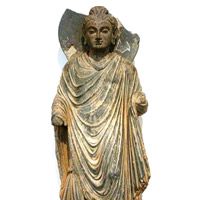Siddhartha was born around 566 BC in Lumbini garden. His family name was Gotama (gotra). He was the only son of a tribal chief, whose tribe was called the Shakyas located in Kapilavastu, capital of Napalese Terai. He was a Kshatriya by cast. He was totally fed up with luxurious life before he was twenty-nine. He left his beloved wife and an infant son in order and began to lead an ascetic life under a tree in a jungle. He adopted the means of self-mortification to purge his soul and attained nirvana. With several years of spiritual exercise he became Buddha (the enlightened one) and was able to inspire great number of people who became his followers. He and his followers devoted their lives to “The Middle Way,” a lifestyle that is midway between a completely ascetic lifestyle and one that is world-devoted avoiding two extremities of severe penance or unbearable ascetic practices. It consists of the Noble Eightfold Path — “Right Views, Right Resolve, Right Speech, Right Conduct, Right Livelihood, Right Effort, Right Recollection and Right Meditation.” It also entails the elimination of thirst or desire, which causes rebirth and consequent suffering and bears philosophy of sarvam dukkham meaning everything is sorrowful. Desire sticks a person to his self, which is transient. This is the Buddhist concept of sarvam anityam, i.e., everything is transient. His preached for several decades in the region of Bihar and Uttar Kadesh and breathed his last in his eighties.
The religion of the Buddha, which came to be known after him as Buddhism, promulgated a moral way of life without any ritualistic performances or the worship of gods. Thus it was considered to be one of the major challenges to Vedism due to its rapid popularity among the people.
This article was last updated on Monday, Jan 03, 2005



